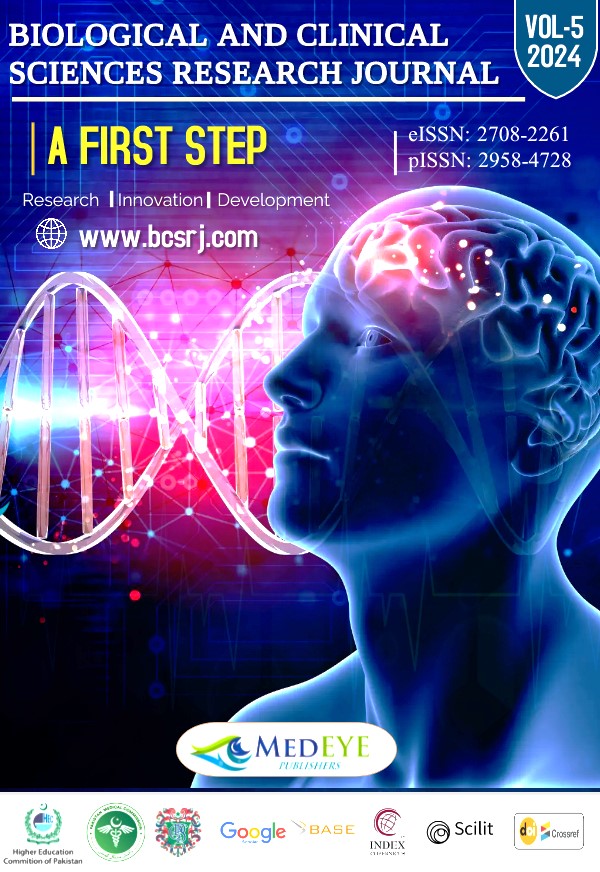THE IMPACT OF ELEVATED LIVER ENZYMES AND İNTRAHEPATIC CHOLESTASIS OF PREGNANCY ON THE COURSE OF COVID-19 IN PREGNANT WOMEN
DOI:
https://doi.org/10.54112/bcsrj.v2024i1.1494Keywords:
COVID-19, pregnancy, liver enzymes, intrahepatic cholestasis, maternal outcomes, fetal outcomesAbstract
COVID-19 in pregnancy presents unique challenges, particularly in the presence of liver dysfunction, including elevated liver enzymes and intrahepatic cholestasis of pregnancy (ICP). These conditions may worsen the disease course and contribute to adverse maternal and fetal outcomes. Objective: To evaluate the impact of elevated liver enzymes and intrahepatic cholestasis of pregnancy (ICP) on the clinical course, severity, and outcomes of COVID-19 in pregnant women. Methods: A retrospective cohort study was conducted at Punjab Medical College Faisalabad during June 2024 to October 2024. A total of 500 pregnant women diagnosed with COVID-19 were included in the study. The patients were divided into three groups: (1) COVID-19 patients with normal liver function, (2) COVID-19 patients with elevated liver enzymes, and (3) COVID-19 patients with ICP. Liver function tests, clinical outcomes, and maternal and fetal complications were analyzed. Statistical comparisons were made to assess the severity of COVID-19 symptoms and outcomes across these groups. Results: Data were collected from 500 patients, with no significant differences in age (31.4 ± 5.2 years vs. 30.8 ± 4.9 years, p = 0.24), gestational age at diagnosis (26.5 ± 4.1 weeks vs. 27.1 ± 3.8 weeks, p = 0.18), pre-pregnancy BMI (26.3 ± 4.5 vs. 25.8 ± 4.1, p = 0.15), or comorbidities such as diabetes (18% vs. 16.8%, p = 0.57) and hypertension (12% vs. 11.2%, p = 0.73). However, clinical outcomes differed significantly between the groups. The liver dysfunction group had a higher hospitalization rate (72%, 180/250 vs. 48%, 120/250, p < 0.001) and a greater proportion of ICU admissions (22%, 40/250 vs. 12.5%, 15/250, p = 0.02). Conclusion: Elevated liver enzymes and ICP in pregnant women significantly worsen the clinical course and outcomes of COVID-19. These conditions are associated with increased risks of severe maternal complications, adverse fetal outcomes, and the need for intensive medical care. Early detection and management of liver dysfunction in pregnant women with COVID-19 are critical for improving outcomes.
Downloads
References
Denızlı R, Sakcak B, Farisoğulları N, Peker MEM, Sınacı S, Kara Ö, Tanacan A, Tekın ÖM, Şahın D. The İmpact of Elevated Liver Enzymes and İntrahepatic Cholestasis of Pregnancy on the Course of COVID-19 in Pregnant Women. SN Compr Clin Med. 2022;4(1):184. doi: 10.1007/s42399-022-01267-1. Epub 2022 Aug 11. PMID: 35971435; PMCID: PMC9366840.
World Health Organization. Coronavirus disease (COVID-19) dashboard. World Health Organization; 2020. Available from: https://covid19.who.int/. Accessed July 28, 2021.
Bourgonje AR, Abdulle AE, Timens W, Hillebrands JL, Navis GJ, Gordijn SJ, et al. Angiotensin-converting enzyme 2 (ACE2), SARS-CoV-2 and the pathophysiology of coronavirus disease 2019 (COVID-19). J Pathol. 2020;251(3):228–248. doi: 10.1002/path.5471.
Chai X, Hu L, Zhang Y, Han W, Lu Z, Ke A, et al. Specific ACE2 expression in cholangiocytes may cause liver damage after 2019-nCoV infection. BioRxiv. 2020. doi: 10.1101/2020.02.03.931766.
Wang D, Hu B, Hu C, Zhu F, Liu X, Zhang J, et al. Clinical characteristics of 138 hospitalized patients with 2019 novel coronavirus-infected pneumonia in Wuhan, China. JAMA. 2020;323:1061–1069. doi: 10.1001/jama.2020.1585.
Docherty AB, Harrison EM, Green CA, Hardwick HE, Pius R, Norman L, et al. Features of 20133 UK patients in hospital with COVID-19 using the ISARIC WHO Clinical Characterisation Protocol: prospective observational cohort study. BMJ. 2020;369:m1985. doi: 10.1136/bmj.m1985.
Lin L, Jiang X, Zhang Z, Huang S, Zhang Z, Fang Z, et al. Gastrointestinal symptoms of 95 cases with SARS-CoV-2 infection. Gut. 2020;69:997. doi: 10.1136/gutjnl-2020-321013.
Mao L, Jin H, Wang M, Hu Y, Chen S, He Q, et al. Neurologic manifestations of hospitalized patients with coronavirus disease 2019 in Wuhan, China. JAMA Neurol. 2020;77:683–690. doi: 10.1001/jamaneurol.2020.1127.
Kabbani N, Olds JL. Does COVID-19 infect the brain? If so, smokers might be at a higher risk. Mol Pharmacol. 2020;97:351–353. doi: 10.1124/molpharm.120.000014.
Xu H, Zhong L, Deng J, Peng J, Dan H, Zeng X, et al. High expression of ACE2 receptor of 2019-nCoV on the epithelial cells of oral mucosa. Int J Oral Sci. 2020;12:8. doi: 10.1038/s41368-020-0074-x.
Nardo AD, Schneeweiss-Gleixner M, Bakail M, Dixon ED, Lax SF, Trauner M. Pathophysiological mechanisms of liver injury in COVID-19. Liver Int. 2021;41(1):20–32. doi: 10.1111/liv.14730.
Bernal-Monterde V, Casas-Deza D, Letona-Giménez L, de la Llama-Celis N, Calmarza P, Sierra-Gabarda O, et al. SARS-CoV-2 infection induces a dual response in liver function tests: association with mortality during hospitalization. Biomedicines. 2020;8(9):328. doi: 10.3390/biomedicines8090328.
Kulkarni AV, Kumar P, Tevethia HV, Premkumar M, Arab JP, Candia R, et al. Systematic review with meta-analysis: liver manifestations and outcomes in COVID-19. Aliment Pharmacol Ther. 2020;52(4):584–599. doi: 10.1111/apt.15916.
Chen L, Li Q, Zheng D, Jiang H, Wei Y, Zou L, et al. Clinical characteristics of pregnant women with COVID-19 in Wuhan, China. N Engl J Med. 2020;382(25):e100. doi: 10.1056/NEJMc2009226.
Sahin D, Tanacan A, Erol SA, YucelYetiskin FD, Besimoglu B, OzdenTokalioglu E, et al. Management of pregnant women with COVID-19: a tertiary pandemic center experience on 1416 cases. J Med Virol. 2021. doi: 10.1002/jmv.27423.
Abu-Hayyeh S, Papacleovoulou G, Lövgren-Sandblom A, Tahir M, Oduwole O, Jamaludin NA, et al. Intrahepatic cholestasis of pregnancy levels of sulfated progesterone metabolites inhibit farnesoid X receptor resulting in a cholestatic phenotype. Hepatology. 2013;57(2):716–726. doi: 10.1002/hep.26055.
Williamson C, Geenes V. Intrahepatic cholestasis of pregnancy. Obstet Gynecol. 2014;124(1):120–133. doi: 10.1097/AOG.0000000000000346.
Wang X, Tan L, Wang X, Liu W, Lu Y, Cheng L, et al. Comparison of nasopharyngeal and oropharyngeal swabs for SARS-CoV-2 detection in 353 patients who received tests with both specimens simultaneously. Int J Infect Dis. 2020;94:107–109. doi: 10.1016/j.ijid.2020.04.023.
Januszewski, M., Ziuzia-Januszewska, L., Kudan, M. et al. Liver damage profile in COVID-19 pregnant patients. Cell Commun Signal 22, 5 (2024). https://doi.org/10.1186/s12964-023-01285-z
Chau TN, Lee KC, Yao H, Tsang TY, Chow TC, Yeung YC, et al. SARS-associated viral hepatitis caused by a novel coronavirus: report of three cases. Hepatology. 2004;39(2):302–310. doi: 10.1002/hep.20111
Labenz C, Toenges G, Wörns MA, Sprinzl MF, Galle PR, Schattenberg JM. Liver injury in patients with severe acute respiratory syndrome coronavirus-2 infection: a systematic review and meta-analysis. Eur J Gastroenterol Hepatol. 2021;33(9):1194–1200. doi: 10.1097/MEG.0000000000001827
Downloads
Published
How to Cite
Issue
Section
License
Copyright (c) 2024 A KANWAL , S KHAN , A MUNEEB

This work is licensed under a Creative Commons Attribution-NonCommercial 4.0 International License.








